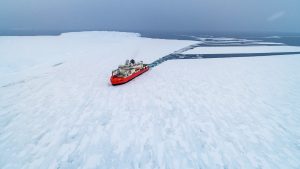On February 22, the Morrison government announced an AU$800 million (US$804.4 million) new funding boost for the Australian Antarctic Program over the next decade, which aims to “strengthen Australia’s strategic and scientific capabilities in the region.” The funding is part of a five-year review and update of the 2016 Australian Antarctic Strategy and 20 Year Action Plan.
Although the announcement did not mention China even once, strategic competition with China’s growing influence and presence in Antarctica is once again a headline in the Australian media. This is in part a question of timing, as the new Antarctica funding plan came shortly after the recent incident of a Chinese navy vessel aiming a laser attack at an RAAF plane in Australia’s exclusive economic zone. Even Chinese media now believes that the new Antarctic funding boost is all about counter-balancing China’s expansion in the Region.
However, is this really the case if we drill down to details?
The 2016 Australian Antarctic Strategy and 20 Year Action Plan provides a clear accounting of Australia’s national interests in Antarctica:
-
maintain Antarctica’s freedom from strategic and/or political confrontation
-
preserve Australia’s sovereignty over the Australian Antarctic Territory, including our sovereign rights over adjacent offshore areas
-
support a strong and effective Antarctic Treaty system
-
conduct world-class scientific research consistent with national priorities
-
protect the Antarctic environment, having regard to its special qualities and effects on the region
-
be informed about and able to influence developments in a region geographically proximate to Australia
-
foster economic opportunities arising from Antarctica and the Southern Ocean, consistent with our Antarctic Treaty system obligations, including the ban on mining and oil drilling.
In my view, Australia’s Antarctic interests are interconnected and mutually supportive. At the core, the goal is to maintain Australia’s sovereignty claim over 42 percent of the icy continent and adjacent waters in the most cost-effective and internationally recognized way. The Antarctic Treaty System (ATS), by freezing territorial claims and devoting Antarctica to peace and science, served Australia’s interests very well over the past six decades.
The rise of China in Antarctica has no doubt raised lots of discussions, debates, and concerns in recent years. China’s fast expansion of its presence in the Antarctic, as well as its vocal and firm practice in ATS meetings, has created a real issue for the Australian government, regarding how to maintain Australia’s leadership in the ATS and, eventually, how to preserve Australia’s long-lasting sovereignty claims. To put it simply, the question is whether to compete or collaborate with China. On one hand, the spirit of the ATS, which was adopted during the climax of the Cold War, is about cooperation. On the other hand, one cannot turn a blind eye to China’s long-term intentions in Antarctica, which Beijing regards as one of its strategic new frontiers.
This “compete or collaborate with China” question began with expert debates, but soon moved into the policymaking space, especially when it came to the proposal of building a 2,700-metrer concrete runway near Davis Station since 2018. It can hardly be denied that the proposal to build the runway was a response to China’s plan of building its first “Antarctic airport” near Zhongshan Station. Amid environmental concerns raised by scientists, it was overwhelmingly argued by strategic scholars that it is “imperative” to build the Davis Aerodrome as a “strategic move” to counterbalance China. Nevertheless, the Australian government finally decided not to proceed with the proposal on November 25, 2021.
What is Australia up to?
Of the AU$800 million funding, a large chunk is going to enhance Australia’s logistics capacity in Antarctica, in particular in East Antarctica where lie Australia’s territorial claim. This includes AU$136.6 million “to support Australia’s inland traverse capability, critical charting activities, mobile stations, environmental protection, and other core activities” plus AU$109 million “to increase aerial and inland capability” through drone fleets, autonomous vehicles, and new helicopters that can be launched from the RSV Nuyina, Australia’s icebreaker. The rest of the funding goes to support Australia’s Antarctic research, environmental protection, and economic opportunities.
These are all allowed by the ATS, though the use of drones fleets may catalyze a further discussions of “dual-use” technologies in Antarctica. In any case, I believe that the decision to abandon the Davis Aerodrome, together with the new funding announcements, marks a pragmatic Australian Antarctic policy, one that takes a different path from the “compete or collaborate” narrative.
Competition is not a good option for maintaining the stability of the ATS, which serves Australia’s national interests. As I argued in a previous piece, building more infrastructure with significant environmental impact could damage Australia’s reputation of protecting Antarctica’s unique and vulnerable environment, which will in turn not be helpful to uphold environmentalism as a key pillar of the ATS. Besides, an infrastructure build-up could become a highly costly and endless competition that may escalate geopolitical tension in the context of Antarctica. By contrast, enhancing logistics capacities is a wise move to make sure Australia is fully aware of what’s going on in the vast continent. Plus, science is the currency of the ATS; a funding boost to Antarctic science is always instrumental to Australia’s leadership role in the ATS.
From an international law point of view, compliance with the ATS and other international treaties is not necessarily based on power or violence. Rather, it can depend on a common belief in all countries doing the right thing. Australia, as a self-claimed leader of the Antarctic affairs, must set a positive example of following the rules.
In short, it seems that based on a very careful calculation, the Morrison government has made a good move in its Antarctic policy. Australia is doing its best within the ATS, bearing in mind the sour Australia-China relations and a rising China in the Antarctic.

































